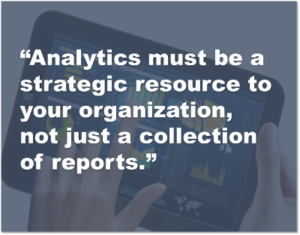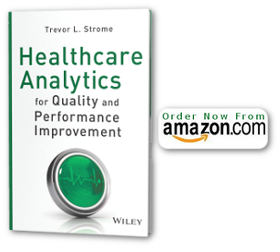
The challenge: how can organizations leverage available data and analytics resources in innovative (and revolutionary) ways to achieve breakthrough transformation in quality, performance, competitiveness, and customer satisfaction?
Many organizations feel that “leveraging data” means building many reports, and fulfilling a high number of ad hoc data requests, as if the volume of reports & requests is an accurate reflection of analytics value and team productivity. What many organizations don’t realize is that many of the ad hoc data requests are necessary because the reports being built don’t really answer the needs of decision-makers in the first place. In reality, high numbers of reports and ad hoc data requests likely indicate that analytics are not deployed nor utilized optimally within an organization.
Analytics must be a strategic resource for operational transformation within your organization, and not just a collection of reports. But if the analytics team is struggling to keep up with all the analysis to be done, how do they know if they are, or make efforts to become, a “strategic resource”? One point of clarification: I don’t mean strategic in the sense of serving only executive level stakeholders; on the contrary, to serve an organization well, analytics must penetrate all levels of an organization to inform better decision making. Strategic, in this sense, simply refers to analytics being seen as a true investment that provides value to the whole organization, not simply a cost centre that some people use to pull data.
Analytics become a strategic resource for your organization through understanding the organization’s information and decision-making needs and by using analytics to identify opportunities for improvement, transformation, and even breakout performance. This understanding is achieved through:
- recognizing the context (i.e., business and quality improvement goals) in which analytics are being applied, and
- through extensive dialogue with key stakeholders regarding their data and decision making needs.
With context and dialog illuminating the performance goals of the organization, the innovative use of data analytics can help achieve superior depth and clarity of insight into performance, quality, and operations. This is only possible, however, when organizations:
- have access to the right financial, process, and domain-specific data from various source systems,
- have the proper analytics teams in place with required knowledge and skill sets,
- apply the most suitable analytical techniques (i.e., predictive modelling, simulation, machine learning, etc) using the most appropriate tools (or software), and
- deploy analytics via the necessary enabling technology (i.e., cloud service or on premise hardware).
There are many more considerations to an analytics system within an organization than simply what, or how many, reports need to be developed. Only by considering all these six points (context, dialogue, data, teams, tools & techniques, & technology) can organizations begin to realize the potential of analytics as a truly strategic resource central to transformation efforts. Otherwise organizations will remain trapped in the “reporting rut” with no discernible path for analytics to help achieve the transformational performance desired.

{ 0 comments… add one now }